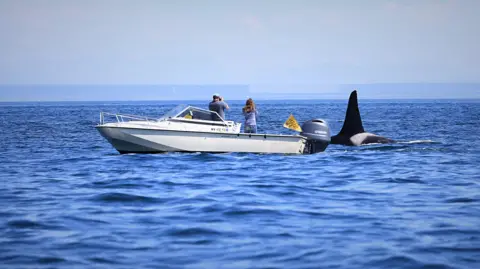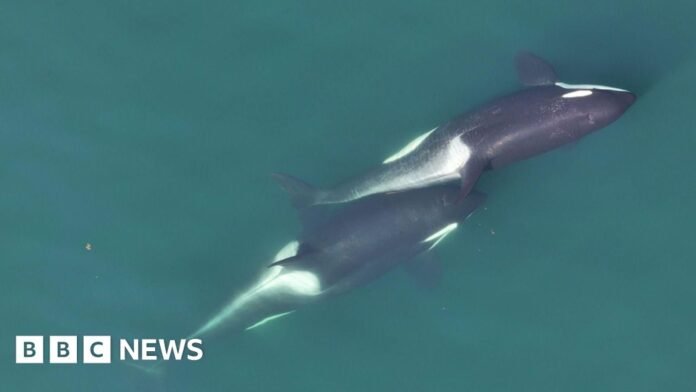Science correspondent, BBC News
Orcas in the North Pacific have been seen “massaging” each other – rubbing pieces of kelp between their bodies.
Using drones, researchers filmed the animals selecting and biting off the kelp, then placing the tube-shaped piece of seaweed onto the back of another whale.
The scientists think the massages might have a health or hygiene function, but they also believe they are a form of social bonding.
The findings, published in the journal Current Biology, appear to be an example of tool use in killer whales – with the animals fashioning a tubular piece of seaweed and using it for a specific, planned purpose.
 Victoria Gill
Victoria Gill“Let’s call it a kelp massage,” explained Prof Darren Croft from the University of Exeter and the Center for Whale Research in Washington State.
“They’re using the kelp to rub between themselves.”
During 12 days – between April and July 2024 – of studying a population of orcas known as the Southern Residents in the coastal waters off Washington State, the team recorded 30 bouts of kelp massage.
“We see it multiple times per day,” lead researcher, Dr Michael Weiss from the CWR, told BBC News. “When we get a drone over these animals, we’re going to see at least one pair of whales doing this.”
This could be a marine version of what is known as allogrooming in primates. Many monkeys and apes groom other members of their groups – spending hours picking through fur, cleaning and removing parasites.
The researchers have dubbed this behaviour as “allokelping”.
Physical touch in animals, Prof Croft explained, “is really important for building and maintaining social relationships.
“And these killer whales are incredibly social animals,” he added.
 Center for Whale Research, NMFS Permit 27038
Center for Whale Research, NMFS Permit 27038The scientists have been using drones for almost a decade to study these marine mammals.
That aerial view has given them new insight into underwater behaviour – including how and with whom the animals socialise.
“What’s incredible with this discovery is that – with high quality video – we could see that a lot of this physical contact [between these large whales] is happening with the aid of this relatively small piece of kelp.”
There was some indication that whales with “more peely skin” were more likely to engage in the massages. “That’s pointing towards the idea that they’re ‘scratching an itch’ – that it has a function in skin health,” said Prof Croft.
It is not clear whether this type of grooming behavior is unique to the Southern Residents or if it is more widespread among other whale populations – and even other species.
But Dr Weiss said that the discovery – that whales were manufacturing tools, “and that these objects were being used in a way never before reported in marine mammals, was incredibly exciting”.
The study of this threatened killer whale population, which lives in the coastal waters between Vancouver and Seattle, was started by Dr Ken Balcomb more than 50 years ago.
Initially, he wanted to examine the threats to their survival, particularly as the population was targeted for capture and sale to some marine parks.
As well as garnering the southern resident killer whales official protected status, the ensuing years of work and observations went on to reveal insights into killer whale life that could only have come to light through decades of study. The studies have revealed, for example, the vital role of killer whale grandmothers and how much the females sacrifice to support their sons.
Dr Weiss said the new finding highlighted “yet another way these whales’ society and culture is unique and the importance of recovering the southern resident killer whale population”.







